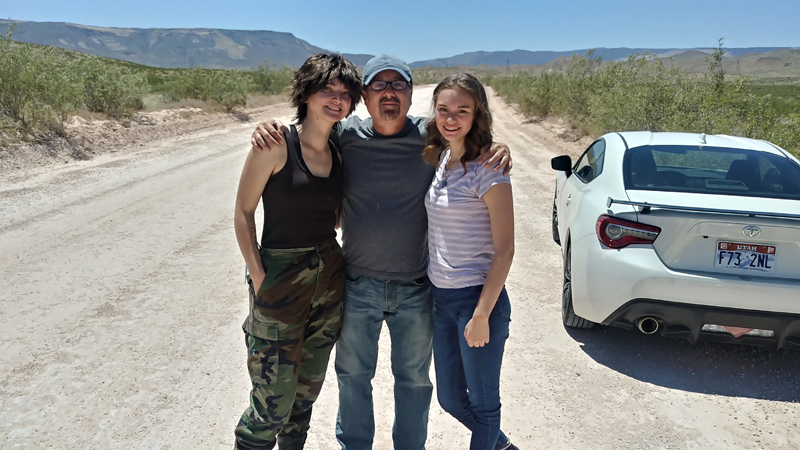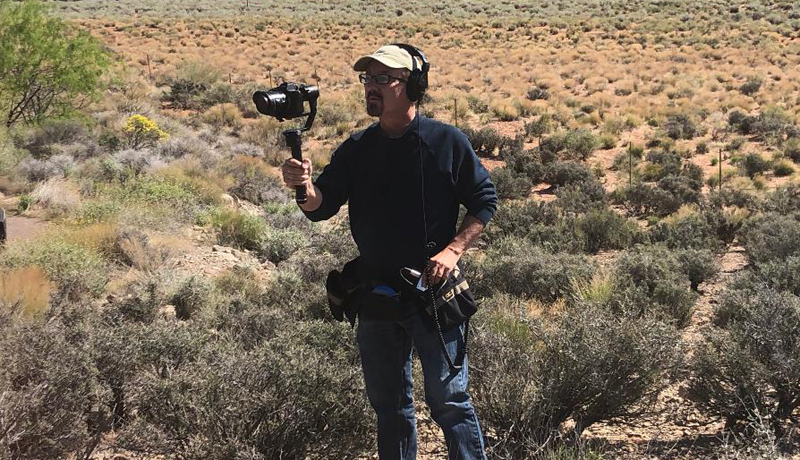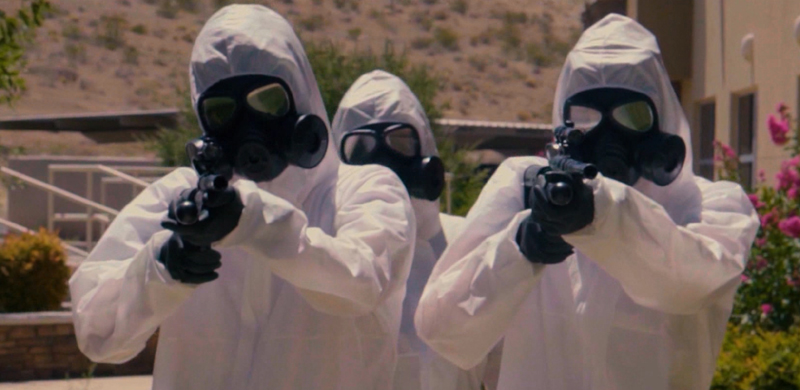An Interview With Filmmaker Richard Lowry

We were recently given the opportunity to sit down and chat to filmmaker Richard Lowry. We had a great time drinking coffee and talking about his upcoming film After The Pandemic, filming on a budget and much, much more…
Hi Richard. Thanks for taking the time out to chat to us.
How have you been managing during the Pandemic?
I’m normally an LA resident but was in St. George, UT hanging with my brother Tor when the pandemic hit. It was safer to stay in St. George since the infection levels were low. My next film, THE REINCARNATION OF EMILY TODD was slated to begin filming in Oklahoma, but when that project was postponed I decided to take the ‘Robert Rodriguez’ challenge and make a feature film for $10,000 with zero crew, utilizing locations across Utah, Arizona and Nevada. 57 days of principal photography and filming in over 50 locations, we came out unscathed. Over the year that we worked on the film the Covid cases were low here so we easily evaded the virus.
So we have Robert Rodriguez to thank for inspiring you to mak this movie.
Can you tell us a little bit about your background and how you got into filmmaking?
I began making Super 8 films as a kid and by age 21 I made my first feature, HAWK JONES, which has recently become a novelty cult film, since the film is comprised of an all-child cast playing adults. Childish Gambino even made a song called HAWK JONES as a tribute to the film. Over the years I’ve made over a dozen indie features and a few have received acclaim from critics like Harry Knowles and Leonard Maltin.
Wow! That is amazing. It just goes to show you don’t know who is out there watching your movies.
Has the pandemic restricted your filmmaking?
The Pandemic in no way restricted us from filming AFTER THE PANDEMIC. Our locations were outdoors, primarily desert terrain and isolated regions of Southern Utah and Arizona. My actors and I may have been the safest people during the pandemic!
How did you find filming during the pandemic?
Since we had no scenes with large groups of people, we all felt comfortable working together over the course of filming. We took all of the necessary precautions and had no issues.
You created ‘After The Pandemic’ with zero crew! How challenging was that?
I’ve directed a film with a 60 man crew on a tight 17 day shooting schedule and it’s pretty stressful. 12-14 hour days frantically trying to get the daily page count was a formidable challenge. On the flip side, working with zero crew, the filming was very leisurely since we had no deadline. I’d film with the actors an average of 3-4 hours a day and we took our time, had lots of breaks, playtime, so it was a pleasurable experience. If the weather was bad or the actors became fatigued, we’d stop shooting and resume another day. This way my actors were always fresh when we began a new day, they didn’t burn out.
That must have been a great change of pace for you. Did you come up with any challenges?
The constant challenge was being aware of my $10,000 budget and finding shortcuts to avoid going over budget. The biggest hurdle and expense was locating the necessary vehicles for the film since St. George is relatively a small city. In certain cases I had to go to Las Vegas to rent the large Stalker vans used in the movie. My producer, Francesca Zappitelli, working on the film from her home in Burbank was a life saver in this department.
Using the Sony A7SII camera, with its amazing features, allowed me to film without a camera crew. The camera is extremely light sensitive which allowed me to film 90% of the film with natural ambient light. One scene was filmed entirely with moonlight. My only tools for this production was a $60 tripod, a dollar store bounce card, headphones, a Tram lavalier mic and a $500 gimbal. I wore a utility belt which allowed me to keep all of my accessories handy. The only downside as a lone filmmaker is the manual labor — moving debris out of the scene or in one instance, emptying out a mountain of garbage from a dumpster to film in, then replacing the garbage. There was nothing glamorous about it but the compromise was well worth it.
Emptying out a dumpster? That is real dedication.

How did casting take place during the pandemic?
The casting for PANDEMIC was very unconventional. I worked with Eve James and Kannon Smith on my prior film SAVAGE CREATURES and liked what they did, even though neither had a speaking role. When I devised the screenplay for PANDEMIC I pre-casted them without them knowing it. I wrote their characters to closely match their actual personalities, which would ease the challenge of playing the roles, since neither was formally trained. I met with the actors and announced that they were starring in my new film — they had no clue, but were very enthusiastic. Thankfully they agreed to take the roles.
Having someone in mind when you write the part definitely helps to shape the character.
Looking at the trailer you wouldn’t think this was made with such a low budget, how did you over come those budgetary restrictions?
Southern Utah has very cinematic terrain. I spent a few weeks scouting locations from Utah to Arizona and found exactly what I needed to give the film its epic feel. Since I owned all of the production gear there were no rental fees. 90% of our locations were free with the exception of three which cost $300 total. Even when I stole locations, no one gave us a second glance, all they saw was a guy with a little camera and two actors. There was no appearance of an actual movie being made. Quite a few local friends of my brother offered their homes at no cost to film in. Since St. George is predominantly a wealthy town, we had access to beautiful homes. As for the post production, I handled almost all of it including the music score. I replaced nearly all of the sound from scratch, spending weeks recording foley, sound effects, vehicles and incidental sounds. We did outsource a dozen shots to a visual effects group in the Ukraine who have very reasonable rates. My producer, Francesca Zappitelli, also worked wonders for this production keeping costs low. Francesca very efficiently produced my last two films, PRESIDENT EVIL and SAVAGE CREATURES.
You and Francesca have done a fantastic job.
Was there any scenes you had in mind that your budget stopped you from capturing?
In a dramatic scene, our two leads are caught in the desert at night with three helicopters hovering with search lights. I envisioned using CG helicopters combined with a practical spot light I used on location. Concerned that the CG wouldn’t play, I instead used B-roll footage of a helicopter I filmed in Glendale, CA a year prior. The scene works better I think, because we’re looking at a real helicopter.
You managed to get some great shots of abandoned cities, how did you manage to capture those seemingly empty cities?
With cities evacuated due to the pandemic it was easy to locate new stock footage of desolate cities across the globe. It was a perfect opportunity to exploit this footage, seeing that this event may not happen again in our lifetimes.
It’s pretty clear that you were influenced by this global pandemic, but what other influences did you have?
I’m a longtime fan of Sci-Fi films. The original ANDROMEDA STRAIN was a big influence, including its music score. I chose to compose a retro-electronic score harking back to the 70’s synth soundtracks. The score is very John Carpenter-esque, I’ve always liked his pulsing music style. Carpenter and Sergio Leone are also big influences in terms of directing style.
We are huge John Carpenter fans so you get a thumbs up from us!
How did you enjoy the experience of making After The Pandemic?
PANDEMIC was one of the most enjoyable experiences I’ve had making a film. My actors and I had a blast, though it was a very physical production. We scaled mountains, large rocky hills, hiked across rough terrain, endured sweltering heat and cold weather. Despite this, we had an adventure like no other and it was a very memorable experience.
That’s great to hear.

Obviously doing everything yourself will have been a challenge. Do you feel like you learnt a lot from the experience?
I’ve been making features for over 20 years and I’m constantly learning new things. I was careful to write the screenplay knowing exactly how to execute each scene and I was mostly successful at capturing my original vision. This can only be learned by years of making mistakes. The most important reward for me as a filmmaker was having the luxury of time. I was constantly returning to locations with my actors weeks after filming was complete to grab new insert shots I discovered I needed for a scene to work, or re-shooting a shot that I knew could be better. On a typical 1-2 million dollar film the filmmaker does not have that luxury, what you film in 17 days is what you get, with maybe one extra day of pick-up shots. I was able to craft PANDEMIC to be the best film I could make with very few compromises.
Is there anything you would do differently if you had to go through it again?
At the moment I feel satisfied that I captured my vision accurately and I’m thankful that Eve James and Kannon Smith exceeded my expectations with their performances. Down the road I’m sure I’ll look at the film more objectively and pick it apart.
We think you have done an amazing job.
We heard that you are a Star Wars fan. What do you think Disney have done with the franchise?
I’m not a fan of the new Star Wars films, they feel very manufactured and not the work of a singular, organic vision. Honestly they feel like big budget TV movies, they lack the heart and spectacle of the original trilogy. I suppose I liked the prequels a hair better, though I’m not a fan of those either.
You can’t beat the originals.
Any advice to anyone looking to break into the industry?
This is the best time for filmmakers ever — we finally have the tools to make quality feature films for the cost of a used car. 20 years ago, AFTER THE PANDEMIC would have required $1-2 million to produce, I’m sure. I predict a best picture Oscar will soon go to a feature film made for $100,000 or less. It’s a very exciting time for us.
Any upcoming projects you can tell us about?
Aside from being a filmmaker I also write actions scripts. SEIZED was released last year, it stars Scott Adkins and Mario Van Peebles. BOUNTY is tentatively due to film later this year starring Michael J. White and Steven Segal. HELLFIRE is currently in development and should begin pre-production later this year, that one will be directed by Isaac Florentine.
My next film as Writer/Director is THE REINCARNATION OF EMILY TODD, a paranormal thriller we’re filming in Oklahoma. This is the film I was supposed to make when the pandemic hit. AFTER THE PANDEMIC wouldn’t have existed otherwise so in a morbid way I’m thankful.
Your certainly keeping busy.
What does the future hold for Richard Lowry?
Eventually I want to move into large budget films, I have quite a few screenplays waiting to be produced. I’m a fan of the 80’s escapist films and those are the kinds of movies I’d like to make that will pack the theaters.
We love 80’s movies so we will definitely be watching out for the them, hopefully in the near future.
We thank you so much for chatting to us Richard, we really appreciate it. Good luck with After The Pandemic. I have a feeling it is going to do very well.
For more information on After the Pandemic Click Here.
You can read more interviews HERE.





